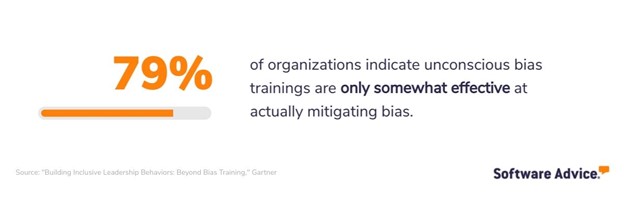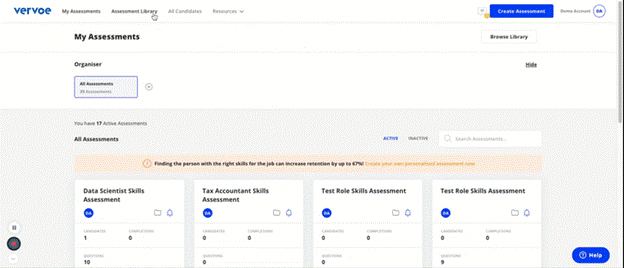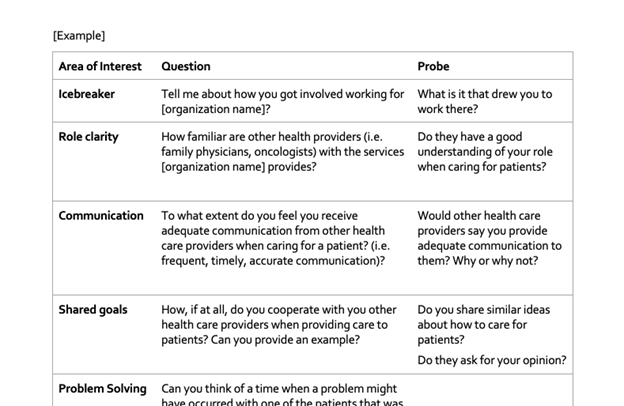Here's How to Properly Conduct a Structured Interview
Diverse teams perform better—it’s been proven over and over again. But while nearly 80% of HR leaders say their organization offers unconscious bias training, the truth is it’s not enough to ensure that underrepresented talent is given a fair chance.[1]

If you’re a recruiting leader or hiring manager, and you’ve noticed that your organization has a pattern of falling short during the talent acquisition process, you need to develop a process for conducting structured interviews.
We’re here to help you do just that. With guidance from Gartner research [2], we put together this comprehensive guide on conducting structured interviews.
First, what is a structured interview?
A structured interview is a technique used by hiring managers and recruiters to vet candidates for an open position. Structured interviews help negate unconscious biases by making sure every candidate has as similar of an interview experience as possible.
This is accomplished by including the following three key aspects in your structured interview process:
All candidates must be asked the same questions in the same order.
All candidates must be evaluated using a common rating scale.
Interviewers must be in agreement on acceptable answers.
Why should recruiters and hiring managers practice structured interviews?
Simply put, structured interviews improve your chance of making a quality hire. In Gartner’s own words: “IT organizations following a formal, structured interview process that prepares hiring managers and other interviewers achieve notable improvement in the quality of new hires who can easily fit in and perform well once onboard.” [3]
Structured interviews are designed so that every candidate meets the same people and answers the same questions. As you’ll learn from the process laid out below, the interviewing team also agrees on what they’re looking for from candidates’ answers ahead of time. This helps hiring teams avoid making decisions based on unconscious biases, instead allowing them to focus on whether the candidate has the experience and skills needed to best fill the open position.
How to conduct a structured interview
Follow the five steps laid out below to start conducting structured interviews at your organization.

1. Analyze the role you are hiring for
To kick things off, choose an open role at your organization that you can use to give this new process a trial run. As you would with any open position, identify the tasks and responsibilities that someone in that role would manage, as well as the competencies and skills they’ll need to be successful overseeing those duties.
To gather this information, consider the following sources:
Job description
Organizational chart
Current employees in a similar role
Supervisor or manager who will oversee the position
Before moving on, determine which competencies can be measured through an interview
Some competencies are easier to measure through an interview than others. For that reason, you should identify whether there are any hard skills that you’ll need to assess candidates for in another way.
For instance, if you’re hiring a project manager, you can get a feel for their communication, leadership, and prioritization skills by asking the right questions. However, a candidate’s technical proficiencies (such as resource management and allocation) are harder to measure through an interview alone—that’s why skills assessments exist, but more on that in the next step.
2. Choose the interview format, and develop a list of questions
Next, decide what the interview process will entail for candidates. Will it involve a panel of interviewers or consecutive one-on-one rounds? Keep in mind that whatever you land on, you’ll have to replicate it exactly for every candidate you interview, so consider the availability of the hiring manager overseeing the role and anyone else who will participate in questioning applicants.
At this stage, you’ll also need to come up with the list of questions to ask each candidate. Your list should include behavioral questions that prompt the individual to open up about their past work experiences, as well as situational questions that shine a light on their instincts. Make sure these questions will help you measure whether a candidate has the soft and hard skills you identified as necessary during the prior step.
INTERVIEW QUESTION EXAMPLES
The difference between behavioral and situational questions is that the former is used to get an idea of how a candidate has operated in their past roles, while the latter is hypothetical. Below, we’ve given examples of each.
Behavioral question: Tell us about a project you recently managed. What did you do when the project was first assigned to you?
Situational question: If you are assigned a project that is lacking key information, how would you go about getting the details you need to be successful?
You should also decide how many probe questions can be asked per interview. Probe questions (also called probing questions) are used to gain clarity or more details from a candidate. For example, “Could you tell me more about that?” and “Can you give us more details about your process?” are both probe questions. For fairness sake, you should have a limit to the number of probing questions interviewers can ask each candidate.
Determine whether you’ll include a skills assessment, and if so, when during the process
The last thing you need to do during this stage is decide whether candidates will also need to complete a skills assessment or work product, and if so, at which point in the process. Skills assessments are typically best for roles that require a specific hard skill or expertise in a particular area—for example, if you’re looking for candidates who can code in a certain programming language.
Tip
Skills assessments are sometimes offered as a feature of applicant tracking systems, which means you can automatically screen candidates as a part of your interview process.

Vervoe’s Assessment Library has options for a wide variety of roles [4]
3. Develop a score or rating scale to measure candidates by
A standardized scale or scoring system to measure candidates by is a must-have aspect of structured interviews. Fortunately, creating a candidate rating scale is relatively simple. Most organizations opt for a one to five scale, where one signifies a candidate is the least qualified, and five signifies they are the most qualified. At the very least, your scale should have three distinct levels, and make sure to label each one so it’s clear to your interviewing team what they mean.
Once you have a rating scale developed, partner with the rest of the hiring team to come up with examples of what a candidate might say or do at each level. The purpose of this is to provide a framework interviewers can use to assess candidates’ proficiency in different skills.
To help you envision what this could look like, we built the table below using our prior example of interviewing candidates for a project manager position.
Score/proficiency level | Competency (Example: Agile project management methodology) | Behavioral/situational example (Example interview question: Tell us about a time you had to manage/prioritize competing stakeholders’ expectations.) |
|---|---|---|
1 (Poor) | Can apply the competency in simple, straightforward situations, but requires extensive guidance. | Blindly completed each stakeholder’s request individually without seeking clarifying information. |
2 (Limited) | Can apply the competency in somewhat complex situations, but requires some guidance. | Prioritized the request that has a more direct impact on the organization’s bottom line, but failed to communicate the reasoning behind the decision. |
3 (Solid) | Applies the competency in complex situations and only needs occasional guidance. | Investigated each request, then prioritized the one that has a more direct impact on the organization’s bottom line. Communicated the process behind the decision to stakeholders. |
4 (Superior) | Applies the competency in considerably difficult situations and needs little-to-no guidance. | Investigated each request, then developed and executed a plan that addressed the priorities of each stakeholder. |
5 (Rockstar) | Applies the competency in exceptionally difficult situations and acts as an advisor to others. | Developed a scale that assigns a level of urgency to incoming tasks that helps prioritize requests now and in the future. |
Our last piece of advice for this step is to encourage interviewers to take notes during their conversations with candidates. This will help prove that the scores they gave candidates are accurate, but it will also help the other members of the hiring team understand how far they made it through the list of questions you developed in step two.
4. Document the process, and create an interviewer’s guide
At this point, you’ve developed a set of interview questions based on the position you’re hiring for, and you’ve also created a scoring system that will help you determine how each candidate’s skill set aligns with the requirements of the role. But before you start meeting with candidates, you need to create an interview guide.
An interview guide is a resource for hiring teams that outlines the standard procedure they should follow when interviewing candidates. It includes a list of questions to ask in a specific order, an overview of the candidate scoring system, and information interviewers should share with candidates about the role, their organization, and the next steps in the hiring process.
If you’ve never created an interview guide before, don’t fret—we put together a downloadable worksheet that walks you through exactly what you need to create this resource.
In order to cut down on the effort you have to put into making interview guides in the future, we recommend creating team- or department-specific guides that you can later use as templates. That way, you’ll only have to gather background information (such as how the team or department is structured) once. And when you need to update it in preparation to fill a new role, you can just add and remove questions so that it’s relevant to the open position.

A preview of an interview guide from Eval Academy [5]
5. Pilot the structured interview process
Lastly, it’s time to give your structured interview process a pilot run. You already chose a role to focus on, so once you’ve got a handful of qualified applicants, start scheduling interviews. And remember: Candidates should speak with the same members of the hiring team, in the same order, and for the same amount of time.
Have each interviewer use the scoring system to rate candidates’ fitness for the position on their own at first to avoid the pitfalls of groupthink. Then, once everyone has met with that candidate, get the hiring team together and calculate the average score for that individual based on each interviewer’s assessment. Ideally, there will be one candidate who is clearly the best fit, and that’s who you should extend an offer letter to. In the case that there’s a tie, take a look at the notes and scores that each member of the hiring team gave for the candidates and make a decision based on those details.
Don’t forget to ask for feedback on the process
Did this new structured interviewing process help or hinder your organization’s efforts to make a quality hire? In order to find out, ask for feedback from members of your hiring team and the candidates you interviewed.
You can either set up a meeting with those who were involved in developing the process and interviewing candidates to discuss their thoughts, or you can take advantage of a survey tool to collect their feedback. And as for the candidate experience, we’ve put together a comprehensive guide on that topic that we highly recommend taking a look at: What To Ask In A Candidate Experience Survey.
Once you’ve collected feedback from your team and the candidates who went through the structured interview process, make adjustments based on their observations. You may find that candidates want more transparency and communication when it comes to where they’re at in the process, or that interviewers need a higher allotment of probing questions—the point is to improve your process based on the feedback received before rolling it out to the rest of your organization.
Looking for more ways to minimize unconscious bias? Check out these resources.
To recap, the five steps your organization needs to take to start incorporating structured interviews into your talent acquisition process are:
Analyze the skills and competencies needed for the role you’re hiring for.
Come up with the interview format and list of questions.
Create a candidate scoring system, and decide what kind of answers you’re looking for at each level.
Create an interview guide—download our structured interview guide worksheet below for help with this.
Pilot the process, and ask for feedback.
And if you’re looking for more resources that will help your organization minimize unconscious bias, don’t miss this related content:
Sources
Building Inclusive Leadership Behaviors: Beyond Bias Training, Gartner
Redesign IT Interview Process to Improve Quality of Hires, Gartner
Step 1 - Creating Questions for your Skills Assessment, Vervoe
Interview Guide Template - Standard Interview, Eval Academy
Note: The screenshots of applications included in this article are examples to show a feature in context and are not intended as endorsements or recommendations.